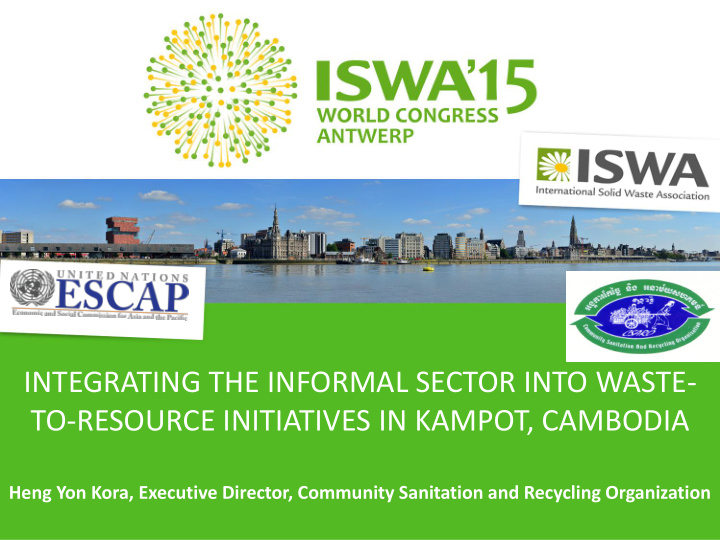



INTEGRATING THE INFORMAL SECTOR INTO WASTE- TO-RESOURCE INITIATIVES IN KAMPOT, CAMBODIA Heng Yon Kora, Executive Director, Community Sanitation and Recycling Organization
City of Kampot City : Kampot Area : 54 sq.km Total Population : 34,325 as of 2002 census Total Sangkat : 5 Total Villages : 15 Waste Generation : 30 tons per day • City is located in a southwestern coastal province • Located 148 km from Phnom Penh This city needs to improve municipal solid waste management • Primary and secondary waste collection, household source separation and fee collection • Transportation, recycling center facilities and disposal facilities dumping site.
Waste management context • Cambodia has several guidelines and policies on solid waste management, including a national 3R Strategy. • Implementation is challenging in most urban areas . Small towns lack waste collection and disposal facilities and collection rates are around 50% or less. There are no sanitary landfills in the country and waste is disposed at open dumps, where burning is often a problem. Illegal dumping is common, oftne into rivers and open spaces. • There is an urgent need for new approaches that are inexpensive and use appropriate technology that can be easily maintained and operated. • In 2010, UN-ESCAP and the Ministry of Environment of the Royal Government of Cambodia organized a national workshop to begin to discuss a project for ‘ Sustainable and pro-poor muncipal solid waste managmenet .’
Overview of the project • Project is implemented through an agreement with the municipal and provincial governments of Kampot, ESCAP and CSARO. • CSARO is the Community Sanitation and Recycling Organization, a national NGO set up in 1997. • Under the agreement, CSARO and ESCAP: • Establish an IRRC in Kampot • Provide assistance to the municipality in developing and implementing plans for the promotion of source separation in the city • Organize informal sector groups (waste pickers) into cooperative or self-help groups • Organize the separation and transportation of organic waste from the markets to the IRRC • Set up a sustainable mechanism for communicating source separation
The role of waste pickers in Kampot • In Kampot, waste pickers are the backbone of recycling and play an important role in terms of primary waste collection and waste separation. • Most waste pickers have good skills and knowledge in waste separation, waste clearning nd processing and sale. • Engaging the informal sector through semi-formal processes can bring many benefits to the city (cleanliness, beautificaiton etc.), municipal budgets and help improve the living conditions of waste pickers. • Waste pickers tend to have low-status in society, and cannot afford health and education. • Semi-formal engagmeent of waste pickers improves their job security, job safety and income.
Challenges of working with the informal sector • But working with the informal sector presents a range of challenges for managers of waste-to-resource iniaitives, including: • Autonomy and independence – Waste pickers tend to work according to their own schedule, needs and preferences. • Individualism – Waste pickers tend to work alone, separately from other waste pickers. The idea of team work is often strange to them. • Variable performance – Waste pickers are often drunk or sick and this effects their perfomance and reliability • Immune to the ‘threat of being fired’ – It is often difficult to fire waste pickers, as their engagement tends to be quais-formal at most • Domestic violence – This effects the capacity of waste pickers to work, and is a frequent issue • Reliability – Waste pickers are not always reliable, due to the above points
Strategy for engaging the informal sector An appropriate strategy for engaging the informal sector is required. This strategy should seek a win-win situation that improves the conditions of waste pickers and performs a key role for the waste-to-resource initiative. • The strategy in Kampot is founded on the following key concepts: • Self-interest – Waste pickers are incentivized through self interest to work. For example, they can keep and sell any recyclable materials they find during the collection of organic waste. • Groupwork and solidarity – Waste pickers are organized in groups, which are semi-autonomous, self-governing but collective. This requires: • Regular meetings for motivation and encouragement • Constant efforts to sustain the idea of a collective or group • Information sharing for team building • Regular reinforcement of key duties and responsabilities of group
The role of the ‘self - help group’ • Waste pickers are organized into ‘self - help groups’ • Each group has a team leader who is the focal point, and liaises between the formal government (Sangkat) and local informal waste pickers. • If a group member is sick or absent, the team leader can visit their house etc. • Each group member is responsible for a different zone of the community. The member is expected to collect organic waste from this zone each day. • Team leaders monitor collection in the zones and tries to keep performance on track. • Team leader also monitors the use of equipment, tools, push-carts and protective gear • If the team leader is not responsible or performs poorly, the team elects a new member through a vote.
Recommendations on how to engage the informal sector successfully for waste-to-resource initiatives • Visit waste pickers communities to discuss opportunities and options • Engage the sector through the establishment of ‘self -help groups’ • Provide capacity building in waste collection, separation and team work management • Provide capacity building on ‘self - management’ for the self -help group • Facilitate monthly meetings for problem solving
Recommend
More recommend